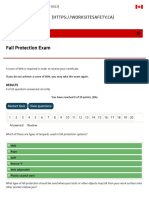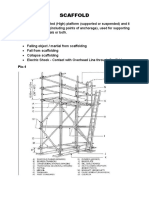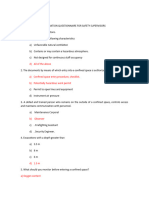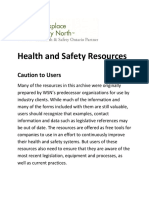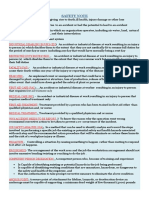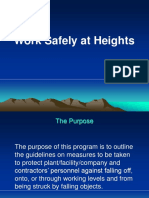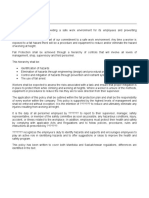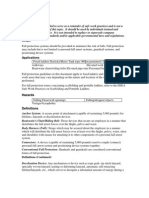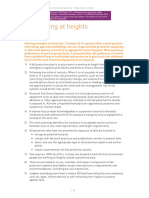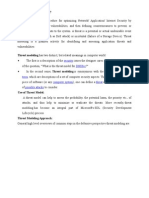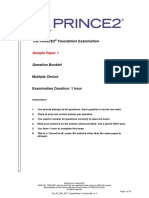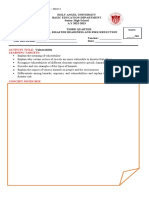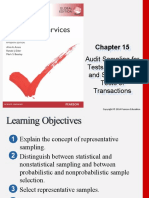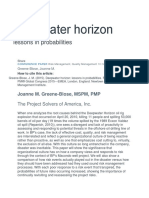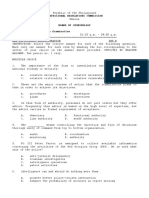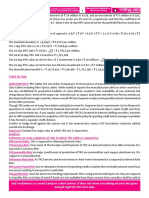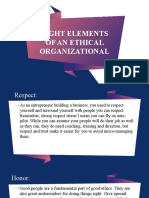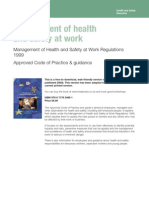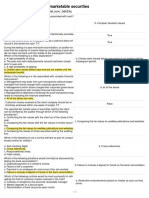0% found this document useful (0 votes)
12 views9 pages5.1 Work at Height - Exam
The document presents an exam on working at heights. It contains questions about concepts such as fall prevention, protective equipment like scaffolding, ladders, and elevated platforms, as well as about anchor points and lines, energy absorbers, risks and controls to prevent accidents such as the use of personal protective equipment and the implementation of procedures.
Uploaded by
ScribdTranslationsCopyright
© © All Rights Reserved
We take content rights seriously. If you suspect this is your content, claim it here.
Available Formats
Download as PDF, TXT or read online on Scribd
0% found this document useful (0 votes)
12 views9 pages5.1 Work at Height - Exam
The document presents an exam on working at heights. It contains questions about concepts such as fall prevention, protective equipment like scaffolding, ladders, and elevated platforms, as well as about anchor points and lines, energy absorbers, risks and controls to prevent accidents such as the use of personal protective equipment and the implementation of procedures.
Uploaded by
ScribdTranslationsCopyright
© © All Rights Reserved
We take content rights seriously. If you suspect this is your content, claim it here.
Available Formats
Download as PDF, TXT or read online on Scribd
/ 9
EXAM
5.1 WORK AT HEIGHT
1) Fall prevention is:
a) Any activity carried out above 1.80 m from the lower level
b) High-risk activity
None
2) A fall with a difference in level is:
a) Fall characterized by the movement between different height levels.
b) They produce blows or fractures
c) None
Fall at the same level
a) Fall linked to contact with interferences at the same level, above or below
supporting surface.
b) Unstable soil (muddy, sandy slopes, etc.) and Obstacles in the soil (roots of
trees, cables secured to fixed objects, stones, etc.
c) Everyone
4) An energy absorber is:
a) Ensure that the braking force applied to the worker does not exceed 900 kgf; it must
resist 5000 lb (2,270 Kg) and its maximum elongation length must not exceed 1.0
m.
b) Fall protection.
c) None
5) Scaffolds are:
a) Metal structural elements, fixed or movable, used for work that does not
can be carried out at floor level and whose duration and/or conditions do not justify the
use of stairs.
b) Locking devices, Security sensors
None
6) LADDER (inclined or mining type) is:
a) Provisional or permanent equipment used for access between levels with a
inclination greater than 15°
b) Adjustable
c) Motorized
7) Portable Ladders is:
a) Portable and lightweight transport equipment, used for temporary access between two
levels, which can be simple, folding, or extendable, being made of fiberglass or
made of aluminum, with a length not exceeding 7m.
b) Support device for working at height
c) None
Platform is:
a) Elements that provide access to two non-contiguous surfaces or supports, located in a
same level.
b) Support infrastructure space
None
9) Elevated platforms are:
a) Mechanical devices, devices with extendable aerial baskets, aerial ladders or
device with articulated tower, vertical or a combination with any of these.
b) Infrastructure to prevent falls
c) None
10) ANCHOR POINTS are:
It must withstand at least 5000 lbf (2270 kg).
b) Minimum resistance 4000 lbf
c) None
11) ANCHOR LINES are:
a) Steel cable fixed at both ends that serves as an anchor for lifelines and
allows horizontal or vertical movement of one or more people.
b) Installed under the supervision of a qualified person capable of supporting 2268 Kg-f or
5000 lb-f per anchored person.
c) All
What is a danger?
a) Risk situation
b) Source, Situation or act
c) None
What is a risk
a) Probability of occurrence of an accident
b) Incident
c) Consequence
14) What are the identified dangers and risks in working at heights:
15) How NEXA prevents accidents:
a) Operational controls implemented
b) Using EPP
c) All
16) What is an Operational Control:
a) A preventive measure
b) Engineering control
None
17) What are the golden rules associated with working at height
a) Use PPE
b) Induction and use of procedures
A and B
18) What are the critical controls that depend on personnel:
a) Be qualified, stay away from dangerous parts
b) Read the procedure
c) Use PPE
The documentation must be aligned with legal and engineering requirements.
equipment with potential risk, as well as those constructed and modified.
a) True
b) False
The work permit is a format to authorize the execution of a job:
a) True
b) False
21) The ramp is an element that serves as access to two non-contiguous surfaces or supports.
located at different levels.
a) True
b) False
The fall arrest device is a device that slides on a life or safety line of any kind.
length and immediately block falls.
a) True
b) False
23) The anchorage driver: It is composed of: Synthetic fiber straps, plates or
forged steel carabiners. They must have a strength of 2270 kg (5000 lb).
a) True
b) False
24) 9% of accidents in the national occupational health and safety statistics correspond to falls
people:
True
b) False
25) Work with the appropriate PPE for the activity.
a) True
b) False
26) Workers must report unsafe conditions or acts to prevent them.
accidents.
a) True
b) False
For routine activities, the risks and specific preventive measures of the process must
to include in the operational procedures of the equipment.
a) True
b) False
28) Non-routine activities must be preceded by risk assessment analysis.
Safe Work (ATS) and the issuance of the work permit.
a) True
b) False
29) A record of the periodic inspections of fall protection must be maintained.
a) True
b) False
30) Conduct periodic or unannounced inspections to verify that all equipment
anti-falls should be in their place and in good condition.
a) True
b) False
31) Verification programs with pre-use checklists and periodic inspection of conditions
of security.
a) True
b) False
It is an operational control:
a. Fall protection equipment
b. Safety harness
c. All
33) To prevent accidents, NEXA has developed
a) Procedures
b) Training
c) All of the above
34) THE PHILOSOPHY OF ACCIDENT PREVENTION and safety in Systems for work
in height, is based on the following premises:
a) Dangerous points and moving mechanisms
b) Staff training
c) None
What is a danger
a) Risk situation
b) Source, Situation or act
c) None
What is a risk?
a) Probability of occurrence of an accident
b) Incident
c) Consequence
37) What are the identified dangers and risks in working at height?
38) How NEXA prevents accidents:
a) Operational controls implemented
b) Using EPP
c) All
39) A preventive measure is:
an Operational control:
b) Engineering control
c) None
Being qualified, staying away from dangerous parts are:
a) Critical controls that depend on personnel
b) Read the procedure
c) Use PPE
It is an operational control
a) Machines must have signaling that adheres to the color code.
b) Unsecured cables
None
The equipment must be installed and used in such a way that risks are minimized.
collaborators.
a) True
b) False
43) Mark the correct answer:
a. Before using equipment, check that its protections and conditions are as
suitable for use
It is common to work without protections but only for a short time to reduce the risk.
c. It is possible to change the guards of the equipment and adapt them, what is important is
that they have guards
d. None is correct.
It is a security condition:
a. Wear tight clothing and tie your hair back
b. Not marking the work area
c. Having a permanent lookout at all jobs
d. Assume that trained personnel no longer needs to be told anything about the jobs
that performs.
e. None of the above
To prevent accidents, NEXA has developed
a) Procedures
b) Training
c) All of the above
46) What is the difference between an anchoring connector with impact absorber and a device
retractable.
a) The first absorbs the energy of a fall and the second does not let it fall.
b) There is no difference, they are identical.
The first is made of textile material and the second is made of metal.
Their connection hooks are made of different materials.
47) To perform work at height or at different levels starting from 1.80 meters, a ...
fall prevention and detection system, composed of:
a) Anchor, connector, and harness
b) harness and lifeline
c) Full body harness and connectors
d) A rope, a belt, and good knots
Team formed by straps, buckles, and 'D' rings, which wrap around the body in such a way
that distribute the force generated in a person when they suffer a fall, reducing the
potential for damage.
Trauma strap
b) Full body harness
c) Lifeline
d) Chest harness
The connectors or carabiners used to join parts of a system or the components
inside the system there must be at least one resistor of
10 KN
22.2 kN
c) 18 kN
9000 Lb-f
The energy absorber to minimize the impact force on the body is used.
mostly in:
a) Positioning systems
b) Energy retention and diversion systems upstream
c) Fall prevention system
d) Constant connection system
51) What part of a fall protection system does an anchorage line belong to?
impact absorber
a) Connector
Harness
c) Anchorage
bra
52) Where on the equipment can you find its technical specifications.
a) Only recorded on the metallic parts.
b) Only on the labels
c) Both a and b.
It all depends on the manufacturer
53) If a team has saved someone from a fall and the impact absorber has not been opened.
a) It can continue to be used if it was reviewed by a competent person.
b) You must be removed from service immediately.
c) Don't give it importance and keep using it.
d) Test by pulling if it leaves a good impression
54) The maximum force that the energy absorber allows to be applied to its body is:
4000 N
10,000 N
12,000 N
It depends on the person's build
55) The average duration of tolerance to suspension with a full body harness is
approximately
a) 15 min
30 min
c) 60 min
d) It depends on the capacity for resistance
56) The fall prevention measures are:
a) Security Network Systems
b) Platforms and Railings
c) All
57) They are lifting platforms:
a) Scissor platforms
b) Articulated platforms
c) All
58) When using portable ladders to access an upper resting surface, the 15
side rails must extend at least 3 feet (0.9 m) over the surface of the
upper rest that is used to gain access or, when such extension is not possible
due to the length of the scale
a) True
b) False
59) A system designed to stop a worker after experiencing a fall is:
a) Personal fall arrest system
b) A line with a damper
c) All
60) Elements of a full body harness:
a) Tie rod, secondary band
thigh band, buckles
c) All
61) When to use an LE-SRL (Retractable System) SRL?
a) When there is a possibility that the line cable may come into contact with any edge
sharp.
b) When you need to connect the self-retracting system below the back ring
of the harness.
c) All
Leading Edge: A work practice where the SRL is anchored beneath the back ring
from the harness and in the fall there is potential over a sharp edge.
a) True
b)False
63) Do not connect a lifeline to a retractable line:
a) True
b) False
64) ANCHOR POINTS are:
It must withstand at least 5000 lbf (2270 kg).
b) Minimum resistance 4000 lbf
c) None
65) ANCHOR LINES are:
a) Steel cable fixed at both ends that serves for the anchoring of lifelines and
allows the horizontal or vertical movement of one or more people.
b) Installed under the supervision of a qualified person capable of supporting 2268 Kg-f or
5000 lb-f per person anchored.
c) Everyone
What is a danger?
a) Risk situation
b) Source, Situation or act
c) None
What is a risk?
a) Probability of occurrence of an accident
b) Incident
c) Consequence
68) What are the identified hazards and risks in working at heights:
69) How NEXA prevents accidents:
a) Operational controls implemented
b) Using EPP
c) All
70) What is an Operational Control:
a) A preventive measure
b) Engineering control
c) None
71) What are the golden rules associated with working at height
a) Use PPE
b) Induction and use of procedures
c) A and B
72) What are the critical controls that depend on personnel:
a) Be qualified, stay away from dangerous parts
b) Read the procedure
c) Use PPE
73) The documentation must align with the legal and engineering requirements of the
equipment with potential risk, as well as those built and modified.
a) True
b) False
74) The work permit is a form to authorize the execution of a job:
a) True
b) False
75) The ramp is an element that serves as access to two non-contiguous surfaces or supports.
situated at different levels.
a) True
b) False
The fall arrest is a device that slides along a lifeline or safety line of any type.
length and immediately block the falls.
a) True
b) False
77) The anchoring driver: It consists of: Synthetic fiber belts, plates or
forged steel carabiners. They must have a strength of 2270 Kg. (5000 lb).
a) True
b) False
78) The 9% of accidents in the SST statistics at the national level correspond to falls
personas
a) True
b) False
79) Work with the appropriate PPE for the activity.
a) True
b) False
Workers must report unsafe conditions or acts to prevent them.
accidents.
a) True
b) False
81) For routine activities, the risks and specific preventive measures of the process must
to be included in the operational procedures of the equipment.
a) True
b) False
82) Non-routine activities must be preceded by risk assessment analysis.
Safe Work (ATS) and issuance of the work permit.
a) True
b) False
83) A record of the periodic inspections of fall protection systems must be maintained.
a) True
b) False
84) Carry out periodic or unannounced inspections to verify that all equipment
anti-fall devices are in their place and in good condition.
a) True
b) False
85) Verification programs with pre-use checklists and periodic inspections of conditions
of security.
a) True
b) False
It is an operational control:
d. Fall protection equipment
e. Safety harness
f. All
87) To prevent accidents, NEXA has developed
a) Procedures
b) Trainings
c) All of the above
88) THE PHILOSOPHY OF ACCIDENT PREVENTION and safety in Systems for work
at height, is based on the following premises:
a) Dangerous points and moving mechanisms
b) Staff training
c) None
89)The risks of vertical jobs affect:
a)Ergonomics
b)Security
c)Both are correct
90)What risks are associated with working at heights?
91) What are the main injuries that workers can suffer after a fall?
from a different height?
92)What aspects should be taken into account in jobs situated at a different
height?
93)Do the personal factors of the workers affect work at heights?
94) Equipment must be installed and used in a way that minimizes risks to the
collaborators.
a) True
b) False
95) Mark the correct answer:
e. Before using equipment, check that its protections and conditions are the
suitable for use
It is common to work without protections but only for a short time to reduce the risk.
g. It is possible to change the guards of the equipment and adapt them, the important thing is
that they have a guard
h. None is correct.
It is a safety condition:
f. Wear tight clothing and tied hair
g. Not marking the work area
Having a permanent lookout on all jobs
Assume that trained personnel no longer require being told anything about the jobs.
that performs.
j. None of the above
97) To prevent accidents, NEXA has developed
a) Procedures
b) Training
c) All of the above
98) The fall prevention measures are:
a) Safety Network Systems
Platforms and Railings
c) All
99) They are Lifting Platforms:
a) Scissor lifts
b) Articulated platforms
c) All
100) If I can choose the height of the anchor point, which one should I choose?
at waist height
b) Above our chest
c) Below the feet




